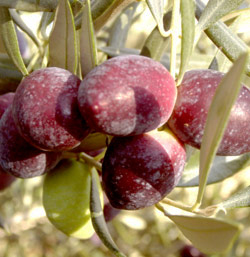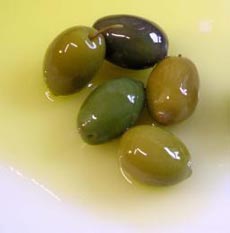Olive Oil & Olives Glossary
Page 8: Terms With P & R
This is Page 8 of the Olive Oil & Olives Glossary. If you think we should consider terms or definitions than those we have provided, use the Contact Us links on this page. Also read our article, Flavors and Aromas of Olive Oil. Visit our collection of 60+ food glossaries to learn more about other food products.
Click on a letter to get to the appropriate glossary page.
a b c d e f g h i j k l m n o p q r s t u v w x y z
This glossary is protected by copyright and cannot be reproduced in whole or part.
PENDOLINO OLIVE
The Pendolino olive trees are the “weeping” olive trees that one sees surrounding the city of Florence. The small olives ripen at mid-season and produce a beautifully fruity olive oil (and are part of the classic “Tuscan blend” along with the Frantoio, Lecchino and Moraiolo varieties); but they also make delicious green and black table olives as well.
 PICHOLINE OLIVE PICHOLINE OLIVE
Picholine is a variety of olive from Languedoc and Lucques in southern France, and also a style of processing these olives, as well as other varieties from Morocco and Algeria. The picholine olive is a medium-size green olive that is elongated in shape. The flavor is mild and nutty, an there is also a mild saltiness as a result of the cure. The bitterness of the olives is removed by treating them in a lye solution for 8 to 72 hours until the lye has penetrated three-quarters of the way through the flesh. They are rinsed several times over the next day or two, and then placed in a brine solution for two days, and then a second brine solution. The acidity is corrected with citric acid and after 8 to 10 days they retain their intense green color and are ready to be eaten. Picholine olives are popular on antipasto platters and served with crisp, dry white wines.
Picholine olive trees are available from
Olive-Trees.net.
PICUAL OLIVE
 Originally from Andalusia, Spain (it is the most widely grown olive variety in Spain and the staple extra virgin olive oil of Andalusia), the Picual is a medium-size olive with an elongated pointed shape. It has a shiny black flesh when fully ripe. It is a full-bodied and flavorful oil; the flavor will vary based on the region, from grassy to woody to intensely fruity. The classic Andalusian oil has notes of fig and fresh bark. The Picual is also used as a table olive. Due to its particular acidic composition, its oil is very stable—it will stay fresh (i.e., not go rancid) for a much longer time than oil from other cultivars. Originally from Andalusia, Spain (it is the most widely grown olive variety in Spain and the staple extra virgin olive oil of Andalusia), the Picual is a medium-size olive with an elongated pointed shape. It has a shiny black flesh when fully ripe. It is a full-bodied and flavorful oil; the flavor will vary based on the region, from grassy to woody to intensely fruity. The classic Andalusian oil has notes of fig and fresh bark. The Picual is also used as a table olive. Due to its particular acidic composition, its oil is very stable—it will stay fresh (i.e., not go rancid) for a much longer time than oil from other cultivars.
Picual olive trees are available from
Olive-Trees.net.
POMACE OLIVE OIL
Pomace oil is the lowest quality of olive oil suitable for human consumption. We don’t recommend it; when it is used with food, it is generally used by manufacturers seeking the least expensive ingredients. It is best used for soap, cosmetics, pharmaceuticals and oil lamps. IOOC Definition: Pomace is the ground flesh and pits after pressing. Olive-pomace oil is the oil obtained by treating olive pomace with solvents or other physical treatments, to the exclusion of oils obtained by re-esterification processes and of any mixture with oils of other kinds. Olive-pomace oil is the oil comprising the blend of refined olive-pomace oil and virgin olive oils fit for consumption as they are. It has a free acidity of not more than 1 gram per 100 grams and its other characteristics correspond to those fixed for this category in this standard. In no case shall this blend be called “olive oil.” It is considered an inferior grade and is used for soap making or industrial purposes.
PROVENÇAL OLIVE
A green olive prepared Provençal-style, marinated in herbes de Provence. The herb mixture can include bay leaf, chervil, fennel, marjoram, mint, oregano, rosemary, summer savory, tarragon and thyme. The olive is often cracked to provide for better marination.
PURE OLIVE OIL or 100% OLIVE OIL or OLIVE OIL
A labeling that indicates only that the contents are 100% olive oil, i.e. that no other types of oil have been added; it does not indicate quality. It can be a blend of refined oil and virgin or extra virgin olive oil and is considered to be minimally processed.
REFINED OLIVE OIL
IOOC Definition: Refined olive oil is the olive oil obtained from virgin olive oils by refining methods which do not lead to alterations in the initial glyceridic structure. It has a free acidity, expressed as oleic acid, of not more than 0.3 grams per 100 grams (0.3%) and its other characteristics correspond to those fixed for this category in this standard. This is obtained by refining virgin olive oils which have a high acidity level and/or organoleptic defects which are eliminated after refining. Over 50% of the oil produced in the Mediterranean area is of such poor quality that it must be refined to produce an edible product. Note that no solvents have been used to extract the oil but it has been refined with the use of charcoal and other chemical and physical filters. An obsolete equivalent is “pure olive oil.”
REGIONAL OIL
Olive oil obtained from olives grown in a particular region of a country. They usually have distinct, identifiable flavors and aromas and may be more expensive than bulk olive oils.
RIPE OLIVE
Olives that are harvested when the fruit is close to being fully ripe, once it has attained the color and oil content corresponding to each particular variety.
ROYAL OLIVE or ROYAL ATLAS OLIVE or ROYAL VICTORIA OLIVE
A large, oblong-shaped Greek olive, with a fruity flavor similar to a Kalamata olive. It is used as a table olive, in salads, pasta dishes and other preparations. It has a red-brown color, although some varieties range from dark brown to light brown.
Continue To Next Page: Terms With S To Z
Go To The Article Index Above
Lifestyle Direct, Inc. All rights reserved. Images are the copyright of their individual owners.

|





 PICHOLINE OLIVE
PICHOLINE OLIVE Originally from Andalusia, Spain (it is the most widely grown olive variety in Spain and the staple extra virgin olive oil of Andalusia), the Picual is a medium-size olive with an elongated pointed shape. It has a shiny black flesh when fully ripe. It is a full-bodied and flavorful oil; the flavor will vary based on the region, from grassy to woody to intensely fruity. The classic Andalusian oil has notes of fig and fresh bark. The Picual is also used as a table olive. Due to its particular acidic composition, its oil is very stable—it will stay fresh (i.e., not go rancid) for a much longer time than oil from other cultivars.
Originally from Andalusia, Spain (it is the most widely grown olive variety in Spain and the staple extra virgin olive oil of Andalusia), the Picual is a medium-size olive with an elongated pointed shape. It has a shiny black flesh when fully ripe. It is a full-bodied and flavorful oil; the flavor will vary based on the region, from grassy to woody to intensely fruity. The classic Andalusian oil has notes of fig and fresh bark. The Picual is also used as a table olive. Due to its particular acidic composition, its oil is very stable—it will stay fresh (i.e., not go rancid) for a much longer time than oil from other cultivars.